The Parks Department Removed the Errant Trees
This morning, as I set the breakfast eggs to boil, I heard the chatter of men outside my kitchen window. My kitchen window faces on to the stem of the “H” of the building in which I live, a kind of courtyard-cum-shrubbery landscape lovingly tended by my neighbor Rose and the various women she gently persuades into to help her, a group I call the “gardening brigade,” a group to whom I do not add my skills, but I have none in that regard.
These men were no friends of Rose’s. They shuffled against the cold with the air of aimless purpose of men brought together to do A JOB. In this case, the JOB was to undo a rather stupid earlier job, namely, to remove a series of four trees planted in the middle of the sidewalk on 29th Street.
You may have read about these trees here or here or here.
I saw them last Thursday, when I ventured out to the drug store upon feeling the swelling of my glands. I knew a cold was coming on and I wanted to get provisioned before I was confined by it. I stopped to take a photo of this sapling planted in the middle of the concrete sidewalk, a location of doom, and then set off to get medication, thinking no more of it until I ran into my neighbor Hannah, who asked me about the trees. I knew nothing more about the trees than any other hapless resident but pointed out that in a few years when the trees grew (if they were permitted to grow), their roots would begin to disrupt the sidewalk, as has already happened on 31st Avenue, in particular the sidewalks abutting the Trinity Lutheran Church.
Then I went home to sniffle into the New Year.
From my laptop on my couch, I typed out my year in reading list for 2023. It struck me as scant. There were many, many books I did not finish last year. I did not finish several poetry books — a few by friends — because it takes me forever to read a book of poetry. I managed the two by Ada Limon only because I was in a wonderful class held by Soapstone where I was easily the least poetry-literate and had to cram to keep up.
I don’t see how a book of poetry can be a page-turner. I’ve never understood the Sealey Challenge — a book of poetry a day for an entire month. A single poem a day would be a lot for me. I am a very slow reader of a poem, and books taken even longer, because I need to think about how the poems are in conversation with one another. Or maybe I am still a novice. Or maybe there is no maybe about that.
Other reasons I did not finish — I was reading the book for research and did not need to know all the particulars of, say, the life of John Winthrop, or the entire history of the coffee industry. Or at least I could skim it, for my purposes. And sometimes I didn’t finish a book because the book did not compel me to finish. There are more books out there awaiting attention.
So without further ado — the list for 2023. Italics means I reviewed it somewhere, and bold means it was a favorite.
Nonfiction
Crying in H Mart – Michelle Zauner
What Are You Looking At – Will Gompertz
Jersey Breaks – Robert Pinsky
Cary Grant’s Suit – Todd McEwen
Invisible Cities – Italo Calvino
Voice First – Sonya Huber
Love and Industry – Sonya Huber
How to Kill a City – Peter Moskowitz
Women We Buried, Women We Burned – Rachel Louise Snyder
Old in Art School – Nell Painter
The Third Rainbow Girl – Emma Copley Eisenberg
The Slip – Prudence Peiffer
Fires in the Dark – Kay Redfield Jamison
Is There God After Prince – Peter Coviello
The Red Parts – Maggie Nelson
St. Marks is Dead – Ada Calhoun
Fiction
The Girls in Queens – Christina Kandic Torres
Babel – R.F. Kuang
Roses, in the Mouth of a Lion – Bushra Rehman
The Cloisters – Katy Hays
Boundless as the Sky – Dawn Raffel
Forbidden Notebook – Alba de Cespedes
The Only Woman in the Room – Marie Benedict
Take What You Need – Indra Novey
Yellowface – R.F. Kuang
Anatomy of a Blackbird – Claire McMillan
All Among the Barley – Melissa Harrison
Normal Rules Don’t Apply – Kate Atkinson
I Have Some Questions for You – Rebecca Makkai
One Woman Show – Christine Coulson
Now is Not the Time to Panic – Kevin Wilson
The Wren, The Wren – Anne Enright
Mysteries
A Time to Kill – Anthony Horowitz
The Twelfth Night Murder – Anne Rutherford
The Bandit Queens – Parini Shraff
The Locked Room – Elly Griffiths
The Stranger Diaries — Elly Griffiths
Poetry
The Gospel According to Wild Indigo – Cyril Cassells
The Hurting Kind – Ada Limon
The Carrying – Ada Limon
I hope when I repeat this post in 2024 that I will report that I have read more entire books of poetry, cleared some of my research shelf, and banged out a draft of dog cafe. Until then, maybe all your trees remain where you plant them!

Kicking and Giving
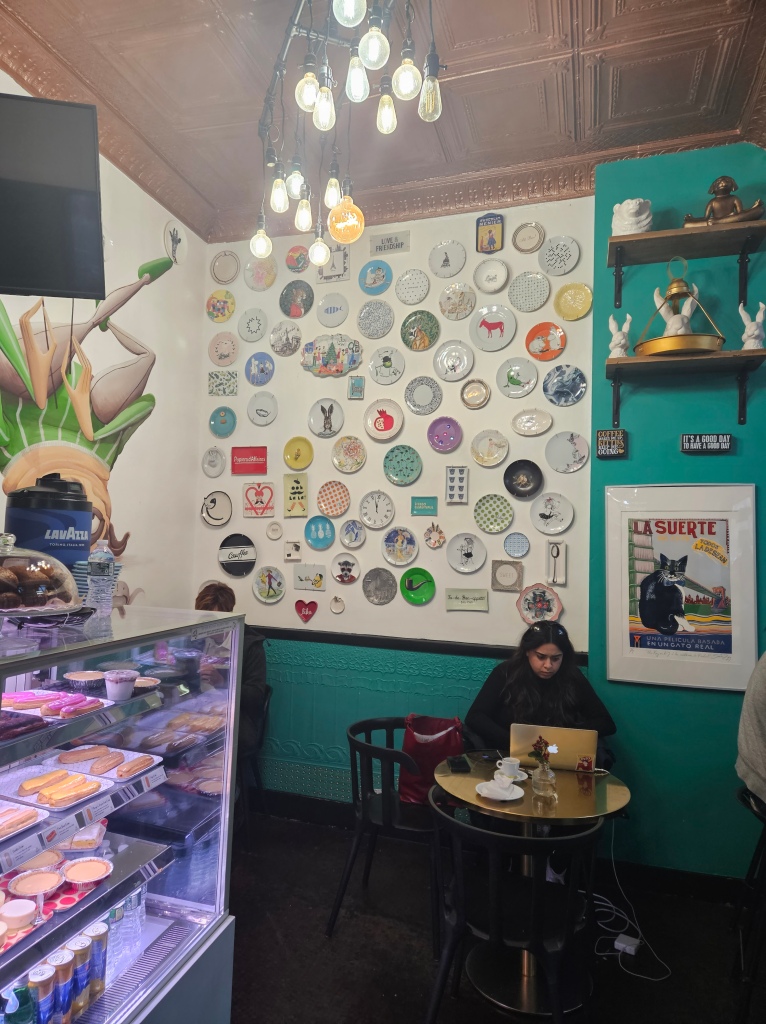
I have now completed the second week of my fully-remote life. My previous job had a one-day-a-week-in-the-office policy for those of us in IT. For some reason, although I was in the research library, I was umbrellaed under IT. (My inability to master layout in the upgraded version of WordPress tells you allyou need to know about me working in an IT department.) When I asked my boss why the library was IT, his reply was “Gotta put us somewhere,” which effectively sums up what led me to leave that job — the lack of engagement, the listless dismissal of legitimate inquiry. The loneliness. In my new role, I am back to research umbrellaed under business development, which sets the world right again, but it is fully remote. Although this is only the difference of one day a week, it is a mindset which sets the mind reeling. To ward off the loneliness, I have committed myself to Pilates and knitting, two things at which I will be terrible for the foreseeable future, but both of which are within walking distance (there are two knitting groups that meet at different bars. I know one stitch.)
And then daily, I take long walks and write in a coffee shop. There is Chateau le Woof, of course, but nearer to home, so that I can get a walk-and-write in before logging on to work, there are three cafes: Under Pressure, Madame Sou Sou and Astoria Coffee. Under Pressure has a high-tech, sleek European vibe, a business-district-transformed-from-its-industrial-past-near-a-branch-of-the-Guggenheim-and-a-W-hotel kind of Europe. Madame Sou Sou has an Old Town European vibe, a cafe-on-a-narrow-street-full-of-quaint-shops-that-are-always-closed-recommended-by-the-landlady-at-your-AirBnB kind of Europe. Astoria Coffee has no European vibe at all. Extremely small even by NYC standards, it is resolutely Astorian, patriotically displaying on its limited wall space art photos of Astoria taken by local photographers.
But it is at Under Pressure where I set my first scene.
Despite its only-in-town-for-fashion-week interior, its clientele is mainly Greek and mainly working class. There is outdoor seating where you can watch the elevated train go by, or watch people line up to order gyros from the Greek on the Street food cart, or watch a traffic cop strolling down the avenue looking for victims. Under Pressure’s employees are Greek,and if their highly amused reactions at my attempts to greet them in their native tongue are any indication, no amount of living in Astoria will help my accent. I was sitting outside with my coffee and my notebook, earbuds in but podcast off. Three men were seated behind me, Queens natives by their accent, contractors by their conversation.
Guy on phone: “Look, I told you I needed you to have the bathroom done by the end of the week . . . that ain’t my problem. . . do what you gotta do. Come in early, stay late, get it done.”
I returned my focus to my to-do list, writing a list of what needed to be written, which is about all the writing I’ve done during the job transition. I heard a voice say “She’s not friendly,” and a moment later a man walked by, his Shiba Inu on a leash trotting alongside him.
Warning: the language below is foul but accurately recorded.
The first man said, “What the fuck! Not friendly!”

The second man said, “The fuck bring it out in public for if it’s not friendly.”
The third man said, “I’ll kick that fucking dog.”
At this point, I pulled out my earbuds and turned around.
The first man at least looked abashed. “Didn’t think you could hear with those things in.”
I explained that the Shiba Inu is a loyal-owner breed, until a few exchanges compelled me to stop. The second man muttered “Shiba Inu,” like it was a new obscenity to welcome into his lexicon. The dog kicker said “I got a pit bull. He don’t like people, I don’t take him outside.”
I held up my palm in the universarl signal for “I will now exit this conversation” that in this case meant “I have no wish to play the extra in a community theater production of Goodfellas.”
Later in the week, I sat at Madame Sou Sou with my coffee and notebook writing about the Under Pressure encounter when I found myself within earshot of a coffee date, a young American man, a young European woman, awkward (“I like your shoes”) and endearing. He explained that he would spend the next day at a “Friendsgiving” and I happened to lift my head in time to see her tumble the phrase in her mind, extrapolating from her familiarity with “Thanksgiving” as a North American holiday to ask “What is a ‘giving’?” .
As he explained, I entertained the idea of a “giving,” a celebration where people gather out of choice, not obligation, not freighted with travel rushes and mandatory dishes, expectations, disappointments, grudges, too much stuffing, stuffing of everything.
So, my friends, I wish you a good giving. (But no kicking.)
Is there a place that means a lot to you?
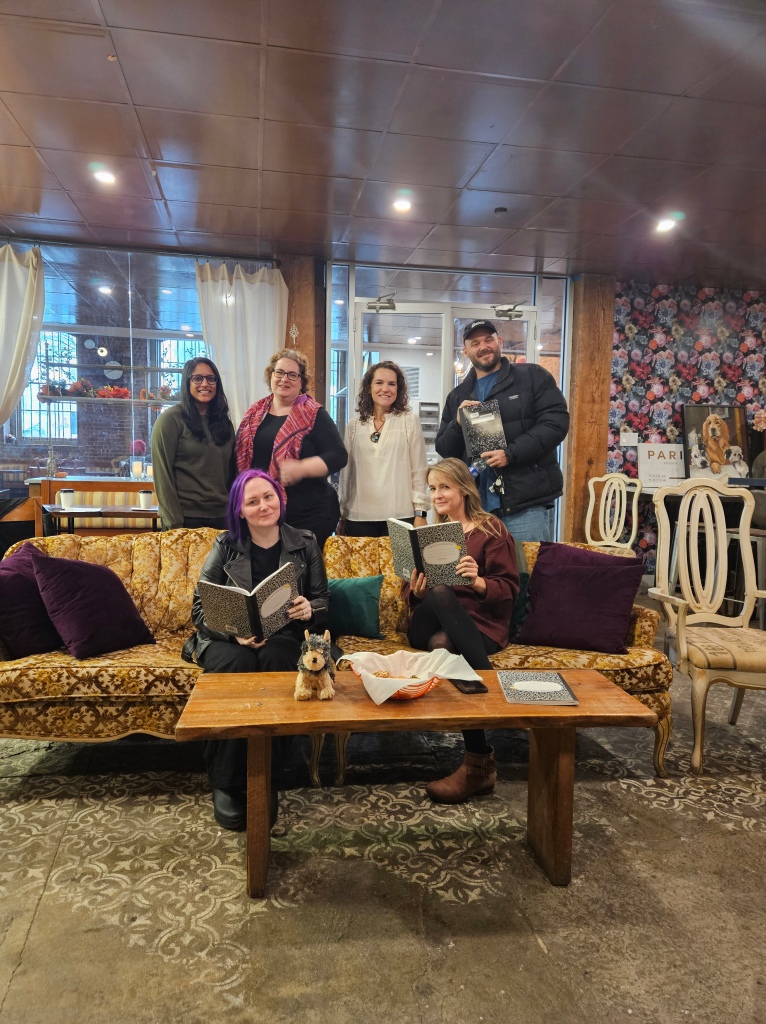
Yesterday I conducted the second of my readings/workshop at Chateau le Woof. It was, New York-famously, the seventh consecutive Saturday of rain, so my expectations of attendance were low. Who would venture through more sogginess to attend a reading of a work-in-progress advertised by an admittedly cute but somewhat vague flyer?
Yet, people came. One was my friend Tess, who I met at the VCFA conference last August, her friend Hannah, two kind neighbors, and a woman who I met in the most interesting manner. This work-in-progress has been a work-in-progress, as I shift and distill its focus from so many tantalizing possibilities. Initially, I began visiting the Chateau le Woof (aka “the dog cafe”) just after the vaccines were rolling out, in the late spring of 2021. I was privileged enough to be able to work from home, but also stir-crazy enough to need to be somewhere other than my home, with other people, yet not indoors. The dog cafe, an indoor-outdoor space, was perfect. I reflected on how we had quarantined ourselves during this pandemic, but during previous epidemics, New York City had quarantined the sick on the islands surrounding Astoria — Roosevelt Island, previously known as Welfare Island and before that Blackwell’s Island, had been home to hospitals, jails, poorhouses and a notorious lunatic asylum. North Brother Island had been home to a tuberculosis hospital. Hart Island was a potter’s field begun after the Civil War and in active use during the height of the pandemic, where graves were dug for the unclaimed dead by the unhappy residents of Riker’s Island.
I still have a draft of that chapter — “Exiles of the Smaller Isles” — but realized I could not use the background research I’d done on Typhoid Mary. She was sentenced to life on North Brother Island, not in the tuberculosis hospital (where she worked as a lab assistant) but in her own small cottage from which, in the imagination of novelist Mary Beth Keane in her novel FEVER, Mary falls asleep to the sound of the rushing currents of the Hellgate, a rapid, still-dangerous stretch of the East River between Ward Island and Astoria. FEVER is an excellent if bleak novel detailing the options of an unmarried immigrant woman at the end of the 19th century. At one point, the caretaker on North Brother Island points out to Mary that her life in her tiny cottage with her little dog, however lonely and powerless, is still much better than some have it.
My favorite of these books was TYPHOID MARY: AN URBAN HISTORICAL which was surprisingly hard to get a hold of, considering its author, Anthony Bourdain. It is top-of-the-game Bourdain, scathing and snappy, but I had to get it on Kindle, because it may be out of print. So it was not among the stack of books I took to the closest Little Free Library. I deposited them and at the same time was delighted to see that the small wooden box held a copy of UNCOMMON GROUNDS, a history of coffee, which was on my list of books I needed for research.
Another woman browsing the Little Free Library eagerly grabbed ALL the Typhoid Mary books, with such enthusiasm that I tilted my head at her. She explained that she was an epidemiologist with the New York City Department of Health.
“So . . . how was your pandemic?” I asked.
She attended the reading, along with her friend, another epidemiologist.
I started keeping this blog such a long time ago that I forget my own logline sometimes, which ends with “champion of the chance encounter.” This was one, if ever there was one.
On Keeping a Notebook
“Keepers of private notebooks are a different breed altogether, lonely and resistant rearrangers of things, anxious malcontents, children afflicted apparently at birth with some presentiment of loss.”
So writes Joan Didion in her essay “On Keeping a Notebook,” which seems to be frequently assigned in graduate-level English classes, so that I was able to snatch this quote off the internet as soon as I determined this morning to write about notebooks. Apparently, when she wrote this piece, keeping a notebook was rare (although no, it wasn’t), or the distinction between notebook and diary had to be made explicit. As far as this quote goes, I say: speak for yourself, Joan.
But to say “speak for yourself,” to Joan Didion is so much a tautology than I can scarcely think of another example, unless it were, say, “Spell it out, Sesame Street.”
I keep a notebook and admit that I am lonely and a malcontent (perhaps another tautology?) but I dispute “resistant rearranger of things” because I’m not sure what it means, and “presentiment of loss” as a child because, in the case of my childhood, it was not a presentiment, but an observation.
I have been thinking lately about notebooks, not only because they are the only things I hoard – I have come to terms with that – and not only because I recently, after several stressful weeks at the day job, rewarded myself by breaking out the fanciest notebook in my hall closet collection.
It is this one, a Japanese notebook from the bookstore Kinokuniya across from Bryant Park. I would say more about the brand but alas, the product information is in Japanese. This notebook weighs too much and costs too much but otherwise, it fits all the criteria for an ideal notebook. It does not impede the flow of writing. It lies flat. The paper is soft enough to be pleasant to the hand resting on it. (The paper in this Kinokuniya notebook is the softest thing I have ever felt that is not fabric, skin or fur.) It is quick to seize ink. It resists a tear (in both senses.) And the notebook itself is sturdy enough to survive the apparent turmoil of the life inside of my handbag.
In the Poetry Folio newsletter released today from Atticus Review that landed in my inbox this morning, poet Michael Meyerhofer reminisced about his favorite notebooks to keep, the free pocket-sized notebooks issued from the bank in the small farming town he grew up in – “twenty or thirty blank pages about as long as your index finger.” He took a stack of them with him to college and maintains an appreciation for them even as electronic note-taking has gradually replaced them. He writes that sometimes all we can do is “fill these tiny little pages while we can.”
A few weeks back, I attended a members-only night at the Whitney Museum, where I learned that the Whitney has a great many members. The Whitney is in its final weeks of an exhibit devoted to Edward Hopper. I learned in the gift shop that Edward Hopper used to roam the city armed with notebooks purchased from the five-and-dime. Edward Hopper! Now here’s a “lonely and resistant rearranger of things”! He found, in the clamor of a relentlessly bustling metropolis, images of solitary and faceless office workers, viewed through plate-glass windows, caught in a melancholy stillness. We might envision Hopper, passing such a scene on the elevated train, which he reportedly rode sometimes all night, grabbing his dimestore notebook to rough out a future painting.
Or we might envision, as a savvier and presumably less melancholy and presentiment-of-loss-afflicted merchandising executive did, reproducing these Woolworth notebooks used by Hopper, with their old-timey typeface announcing their old-fashioned titles – “Ledger,” “Cash,” “Journal” – to sell in the Whitney gift shop for $18.50.
I’m not here to decry the cost. My Kinokuniya notebook — with its more daunting title “Life” — cost even more than that. But I am wondering what is the appeal of the reproduction of a once-cheap, utilitarian notebook. Why has such an object been elevated to the status of a museum gift shop item? The notebook was not designed by Hopper, or touched by Hopper but only implicitly endorsed by Hopper. And even that implicit endorsement is a long stretch. He probably used those notebooks because they were handy. He was a broke artist. He was more interested in the message than the medium.
I don’t know what a buyer of one of these notebooks hopes to be purchasing. Perhaps she just thinks it’s cute. Who am I to judge? (Okay, I’m judging a bit.) But it took me years of this notebook and that one, the here-you-like-to-write gifts and the singular bliss to be found in day job supply closets, to realize what suited notebooks suited me and why. The imperative is that it does not impede the flow of writing. So I have smaller notebooks, pocket-sized ones, old-fashioned reporter notebooks that can fit in one hand while you use the other to write, lightweight notebooks for a weekend trip, steno pads bought at office supply stores if I forgot to bring anything and yes, of course, tiny free pamphlets.
I suppose I would encourage anyone who hopes to channel inspiration by purchasing a reproduction of the kind of notebook Hopper favored to instead find her own notebook. As Cavafy encouraged his readers to find their own Ithaka.
Ithaka gave you the marvelous journey.
Without her you wouldn’t have set out.
She has nothing left to give you now.
But if you were wise, on that journey, you kept a notebook.
My Year in Reading 2022
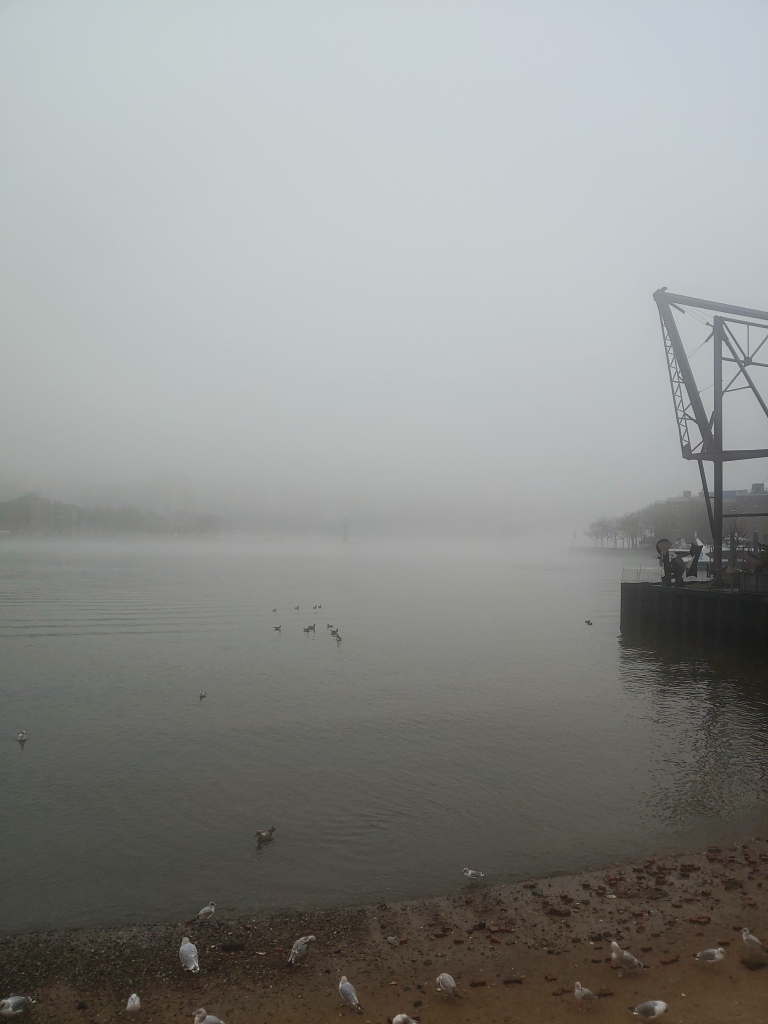
I’m still working on expanding my reviewing, and was fortunate to land a new gig, so I’m looking forward to more in the coming year. I reviewed three books this year. They are therefore disqualified (and indicated in italics) from my top ten. I’ve also ordered several books written by friends but they may still be in the TBR pile, or not yet finished.
So, with the downtime I had at my disposal, excluding periodicals, and listening to podcasts excluded, here are the books:
For research
Typhoid Mary: An Urban Historical – Anthony Bourdain
Terrible Typhoid Mary – Susan Campbell Bartoletti
Deadly – Julie Chibbaro
The Lonely City – Olivia Laing
Open City – Teju Cole
Feral City – Jeremiah Moss
New York City Coffee: A Caffeinated History – Erin Meister
The Power Broker – Robert Caro
John Winthrop – Francis J. Bremer
Eye of the Sixties: Richard Bellamy of the Transformation of Modern Art – Judith E. Stein
The Architecture of Happiness – Alain de Botton
Mark di Suvero (edited by David R. Colleens, Nora R. Lawrence, Theresa Choi)
Work on the work-in-progress progresses, so I have started on readalikes. I’ve realized that there really is no way to tie in Typhoid Mary to the conceit of my book, but I have now read enough on her to consider myself an amateur expert. Halfway through the year I shifted my focus to Mark di Suvero, subscribed to Art in America, downloaded every article I could find at NYPL, and solicited a box of di Suvero family papers from the Smithsonian. And still I know so little that eking out 500 words took all I had.
All that said, The Power Broker occupied weeks and weeks of reading, even with using the audiobook. That book is long. I also saw the David Hare play, Straight Line Crazy, so I’m just about as up on Robert Moses as I am on Mary Mallon.
Reading resolution for this category: Continue with Mark di Suvero. Read other living Queens authors extensively for a workshop I hope to hold, with grants I hope to be granted.
Fiction
Five Tuesdays in Winter – Lily King
The Last True Poets of the Sea – Julia Drake
The Latecomer – Jean Hanff Korelitz
An Honest Living – Dwyer Murphy
Tinker Tailor Soldier Spy – John Le Carre
Mercury Pictures Presents – Anthony Marra
Fellowship Point – Alice Elliott Dark
Natural History – Andrea Barrett
Shrines of Gaiety – Kate Atkinson
About Face – William Giraldi
Trust – Hernan Diaz
Trust Exercise – Susan Choi
I was surprised to see so few novels on my list, again, The Power Broker took up a lot of my summer. I was sad to leave the Lily King and the Kate Atkinson off my top ten list, but the memoirs below just nudged them out. The Marriage Portrait is in the queue.
Reading resolution for this category: See Queens authors, above. Otherwise, I will probably graze indiscriminately.
Memoir
Bluets – Maggie Nelson
H is for Hawk – Helen MacDonald
The Outrun – Amy Liptrot
Also a Poet – Ada Calhoun
The Lost Children of Mill Creek – Vivian Gibson
Easy Beauty – Chloe Cooper Jones
The Odd Woman and the City – Vivian Gornick
Reading resolution for this category: Don’t really have one? Crying in H Mart is waiting for me at the Astoria Library.
Essays
Animal Bodies – Suzanne Roberts
Orwell’s Roses – Rebecca Solnit
Like Love – Michele Morano
Hysterical – Elissa Bassist
Festival Days – Jo Ann Beard
All the Leavings – Laurie Easter
Bright Unbearable Reality – Anna Badkhen
Reading resolution for this category: I hope to review more in this category. I focus on collections published by indie and university presses.
Craft
Craft in the Real World – Matthew Salessas
A Swim in the Pond in the Rain – George Saunders
How to Write One Song – Jeff Tweedy
Reading resolution for this category: I am starting 2023 with a poetry workshop which has two rather daunting required texts, so, dare I say, I am good here?
Other nonfiction
Islands of Abandonment – Cal Flyn
The Strange Case of Dr. Couney – Dawn Raffel
Reading resolution for this category: I realize that this category is composed of writers with whom I took workshops in 2022, both of whom were super-kind and thoughtful.
Poetry
The Owl Was a Baker’s Daughter – Gillian Cummings
Long Rules – Nathaniel Perry
Reading resolution for this category: More, more, more.
Cozy old things and mysteries
Cheerfulness Sets In – Angela Thirlkill
The It Girl – Ruth Ware
The Madness of Crowds – Louise Penny
Dying to Tell – Robert Goddard
Reading resolution for this category: this is the “something fun to read” category. It defies resolve.
Happy reading in 2023 to all!
Mark di Suvero meets the Golden Gate Bridge
I haven’t been posting as often as I would like because I’ve been buried in research for my book about the history of the section of Astoria you can see from Chateau le Woof. The project was previously known as “Summer of the Dog Cafe” but it seems to have morphed into a book and it involves Hallett’s Cove, the former Sohmer piano factory where the dog cafe occupies part of the ground floor, and Socrates Sculpture Park, founded by Mark di Suvero, and Spacetime, the red warehouse which di Suvero uses as workspace. Teaching myself about the Puritans, the history of pianos in New York City, and the rise of public art and then trying to turn it into prose has been a slow process! It took me forever, it seems, for example, to come up with the opening paragraphs of the chapter on Mark di Suvero, but here they are for your appraisal.
In 1941, a family left China to sail across the Pacific, fleeing a war that would not be fled. Although they had been living in China for years, the family was Italian. The father, a naval attaché, was Venetian, as was the mother, a former Countess. With them were their four children, each of whom faced radiant destinies: an activist lawyer who would establish a law school, an art historian, a poet and a world-renowned artist.
Let’s envision the future artist, nine years old, on the deck on the S.S. President Cleveland. His hands, wet with ocean mist, grip the railings as the Cleveland navigates from the great Pacific into San Francisco Bay. Here it is at last: America. America, named for an Italian explorer, just as he was, Marco Polo di Suvero. Perhaps he claps with excitement. We focus on his hands because his early public work will be of hands, clutching, opening, pointing.
Days of gazing at the endless blue of ocean and sky are suddenly broken by the terrible bright splendor of this span of steel, stretching across the bay for a mile, so long that the bridge never stops being painted. The last brush stroke on the south end in San Francisco serves as a signal to commence the next coat on the north end in Marin County. The color of the paint is International Orange. It flares into the eyes of the blue-blinded boy, himself an international fruit, an Italian raised in China entering America under a suspension bridge with towers so tall that they routinely disappear into clouds as though seeking the release of heaven. The bridge was begun the same year he was born, but it is only four years old, like a younger brother.
International Orange is a reddish orange firmly associated with the Golden Gate Bridge. But it is abundant on earth. We find it in the clay soil of Georgia, in the heart of a peach, in marigolds and goldfish, butterflies and autumn leaves, Irish setters and redheads. We find it in flames. But the color really belongs to the sky, in the grace of the sun rising and setting.
But who could imagine dousing a monument of steel with such a fierce, celestial color. The future sculptor Mark di Suvero, first encountering America, was too young to formulate such questions. He was just a boy, and what he most likely thought was “Golly, look at that!” or, more likely, “Che meraviglia!” But that encounter, and that thought, would direct the rest of his life, shape the course of the lives of dozens if not hundreds of other artists, and heavily influence the landscape of a certain stretch of Vernon Boulevard in Astoria, New York.
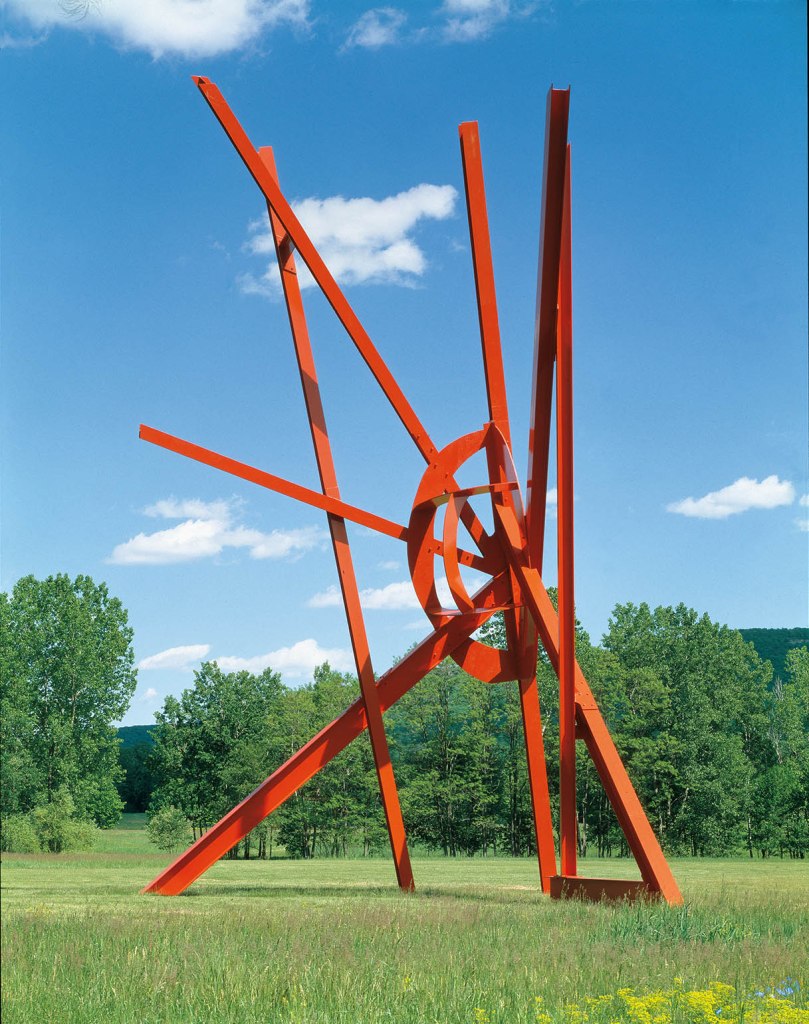
Maybe for the dog days, a collage, a prose poem
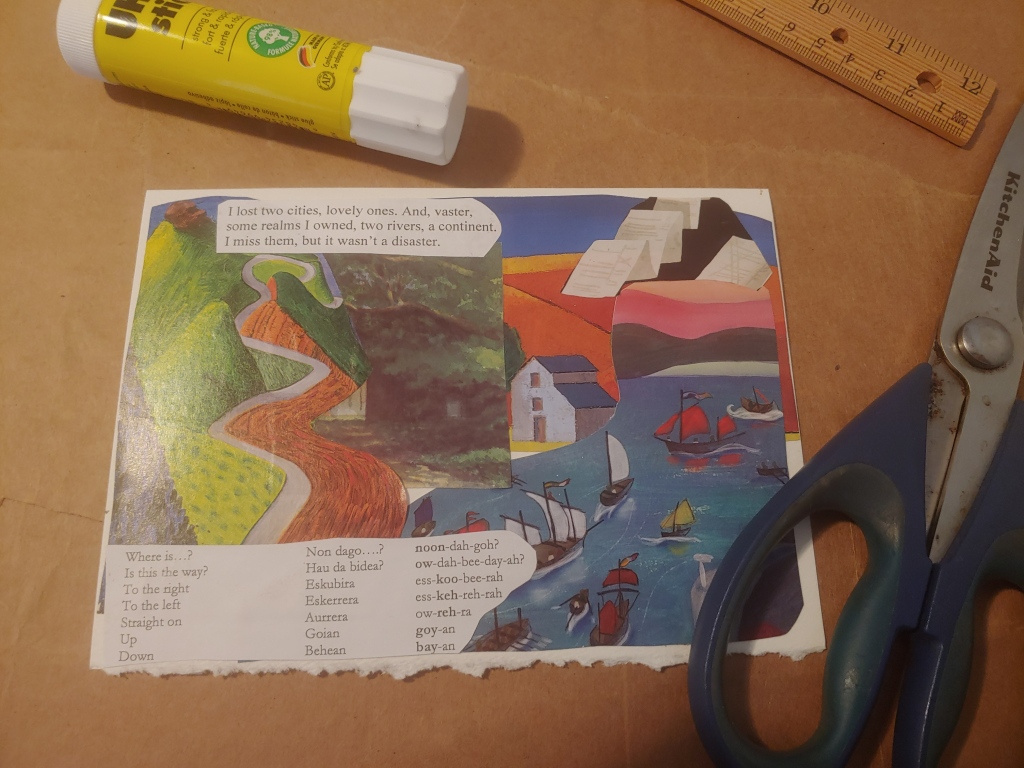
I find the last month of the summer a hard one, I find all holidays are hard when everyone has others. “We always go to my cousins at the lake house,” a woman sighs in my office elevator. “It gets bigger every year, with all the babies, And Aunt Barb.”
The same woman just wept in the Weight Watchers meeting. “It won’t be Thanksgiving without Aunt Barb’s blackberry pie!”
My therapist reminds me, “Don’t say ‘everyone.’ You don’t know ‘everyone.’” She also says “make plans.” Even though all those others at the lake house just go. They are not here to make plans; they will be back after two weeks, say their out of office emails. They don’t plan, they didn’t plan to lose their family so young, they do not need to seek gatherings. They bang pots and pans to keep the deer away from the plumpening blackberry bushes. Aunt Barb prefers to quilt on the screened porch; it is too hot to knit.
Make plans. Like the other doctors say ‘lose weight, don’t eat carbs.’The professor born in Hollywood told me that to succeed in Los Angeles “You have to look a certain way.” Her hand, ringed but not lacquered, rested on my screenplay, unread, un-even-so-much-as-ruffled, why bother? since its author was so very ruffled.
Her eyes sweeping me from head to foot in case I miss her meaning, sweeping from my forehead scars to my feet which can’t bear stilettos.
Make plans. No carbs. You don’t know ‘everyone.’ Or, in that regard, ‘anyone.’
In England they say “the summer hols” to indicate this time when everyone is away and if they have made plans, well . . . looks like you were not included. Even though I don’t know everyone, even though I’m exiled from the California beauty fray. Even though stilettos can’t bear the weight of me, even though I lack an Aunt Barb, the last month is as tart-tough as a blackberry pie with those seeds, those seeds that stick in your teeth forever.
Make My Heart Come All Undone
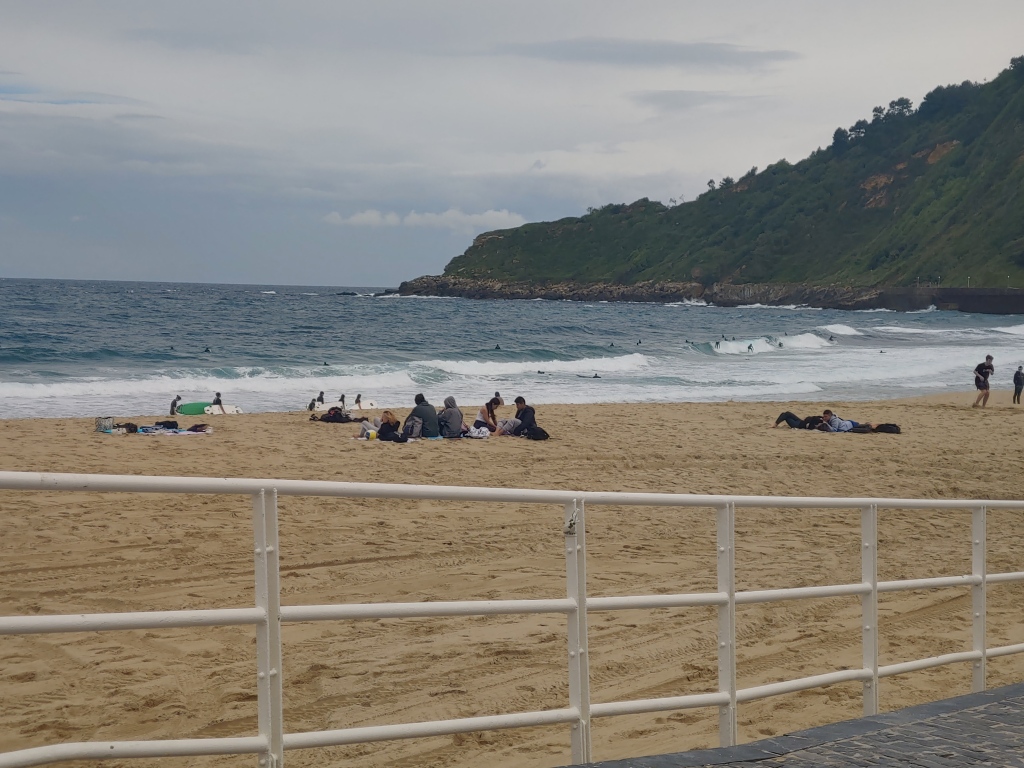
I was in San Sebastian when I took this photo.
I was in San Sebastian, with its endless beauty and tranquil charm, its plentiful pintxos and varying skies, its cute little shops that are closed for so many hours of the working day that you wonder how they stay in business until, after a day or two, you stop wondering that, you stop thinking like an American, focused on profit and how to maximize it, and start thinking more than a San Sebastian, focused on how to enjoy the life you have been given.
A few days ago, I walked across the bridge from the Old Town into Gros. Once of the first things I saw, beyond the vast and unbeautiful performing arts center, was a surf shop. “Surf San Sebastian!” encouraged a t-shirt adorned with little fishes. Sweet. Then a surfer walked past me, clad in a wet suit, carrying a surfboard. Then another surf shop. Then another surfer. I crossed the boulevard and sat on the wall by the beach, and watched the whole bay of them, out on the waves, whatever the collective noun for surfers is. Communion? A communion of surfers, paddling, leaping and falling for just a few possible moments of transcendence.
I watched them for a long time, my heart a precious thrashing thing. I have always loved surfers, which is strange for a stout ungraceful girl from the land-locked midwest. And I have always loved surf music. Dick Dale and Jan and Dean, yes, but especially the Beach Boys. Even I found this odd, in my odd adolescence. My stepsister, captain of the pompon squad, fashioned a sprightly dance routine to “Be True to Your School” for the halftime entertainment of the Kirkwood Pioneers, but I preferred the slower darkness of “In My Room” and “Surfer Girl,” which is neither a tribute nor a love song, since it mentions no actual qualities of the girl in question, but masks a darkness beneath its kind melody, like a bloodthirsty cradle-will-fall kind of lullabye: “Little surfer, little one/make my heart come all undone . . .”
Sometimes in my teenage years I would select this album, “Endless Summer” (even its title a blend of promise and threat), from my collection of Springsteen and Costello, La Traviata and Beethoven’s Ninth, and weep into the false sunshine of the hideous yellow shag carpet my stepmother had chosen to adorn the girls’ bedroom. I heard the shadow in the sunshine before Brian Wilson’s mental problems became public knowledge, before I came to terms with the fact that I would have to reckon with my own on my own, since my parents considered them little more than adolescent indulgence.
And this is as far as I got in my musings before I returned to my budget pension on the boulevard above the little glove shop that was never open, so I couldn’t buy my sister the pair of driving gloves I saw in the window. I returned to my stark room and saw the stark news.
I have been in Spain for ten days now and there have in that time been two mass shootings in the United States. This most recent slaughter of children is covered differently here. There is no braying about the right to bear arms, no hypocritical clucking over “mental health,” no admonishments not to “politicize this tragedy” for those whose politics help these tragedies to occur, but no weepy hand-wringing, either. The latest news from the Estados Unidos is presented at most with a raised eyebrow, but in a straightforward manner, the footage shown between footage of the war in Ukraine and some incident in Brazil, the latest development from another country of violence.
Petrichor!
“Let me tell you about winds,” Almasy says to Katherine Clifton as they shelter in a car from an Saharan sandstorm in The English Patient. “There is a, a whirlwind from southern Morocco, the aajej, against which the fellahin defend themselves with knives.”
I’ve been thinking about The English Patient because it’s one of my movie obsessions but also because I am in the room above the kitchen in the old house here, part of the original structure, a sheep shed, that was all that was here when the owner, Georgina Howard, bought the property. This house reminds me of the villa where Nurse Hana shelters with Almasy, now the English Patient, to allow him to die in relative peace. As the medical convoy moves on, Hana watches from a high window in the villa, chopping off her long hair into a chic bob the way women do in the movies. Disparate characters come and go, a thief called Caravaggio, a Sikh bomb defuser and his sidekick Kevin Whately (that is the actor’s name, I only ever think of him as Kevin Whately) all with their different knowledge, expertise, striving and grief. They come together for a time, and then they part ways.

Let me tell you about winds.
In my room with its view of the roof over the dining room, and then of the valley beyond, I heard the winds around dawn. The nearby wind sounded like the whoosh of the ocean. The approaching wind sounded like a rapidly-arriving locomotive. Not a whirlwind from southern Morocco – Morocco, like all the rest of the world, is far, far away – but a fierce eddy from somewhere that, when it arrived, bent the trees long ago matured into strange undulations like modern dancers.
And then it raised itself up and away.
A few days ago we had a straight, hard rain, after a thrilling prelude of thunder that purred and echoed across the valley. I grated cheese in the kitchen with a keen eye on Chef Carol, who disguises her expertise beneath a mask of amiable vagueness. What’s in the risotto? “Oh, it’s got some shallots and some . . . I chopped . . . did we say 7:15? With risotto, you have to be very precise.”
Outside, the rain stopped. Georgina thundered down the stairs and swept into the kitchen. She is not one to enter a room with hesitation but strides into the action mid-gesture with an urgency to impart, like a herald in a play. But you would not expect a docile demeanor from someone who twenty-odd years ago saw a Basque shepherd’s hut and willed into being a creative manse (or, in Basque, etxe). The central courtyard between the houses is a kind of stage, one where I would happily set a play, a romantic farce, if I wrote plays happily, which I do not.
Georgina cried, “Elizabeth! There is a word for the smell of the earth after the rain! Petrichor!” She rolled the R, so I thought the word must be Spanish or Basque. “Petrichor! From ‘petra,’ meaning earth and ‘cor,’ meaning . . . oh . . .”
From ichor, the term used to describe “the fluid that flows like blood in the veins of the gods” in Greek mythology. According to the Oxford dictionary, the word was first used in a 1964 article written by a group of scientists, which is why we have never heard of it.
“How would you use it in a sentence?” asked one of the writers when we brought petrichor along with the risotto to the dinner table.
I couldn’t think of how to use “petrichor” in a sentence that would not also include the words “smell” or “rain,” which tells me this was not a word clamoring to be coined. I also wonder how these scientists, finding the phrase “the smell of the earth after it rains,” insufficiently pithy to their needs, fell so easily onto “ichor.” Now there’s a word I’d like to use in a sentence. “How do I get this ichor stain out of my dress?”
There is a laurel tree embedded in the patio courtyard. Georgina constructed the patio around it, decided that the tree would be part of the family. In Greek mythology, Daphne, pursued by Zeus, transforms herself into a laurel tree to preserve herself from his lust and other ickiness.
The poem The Laurel Tree by Louis Simpson contains these lines:
“Is there a tree without opinions?/Come, let me clasp you!/Let me feel the idea breathing.”
And ends with these:
“The dish glowed when the angel held it./It is so that spiritual messengers/deliver their meaning.”
The Sheep Are There. The Sheep Are Not There.
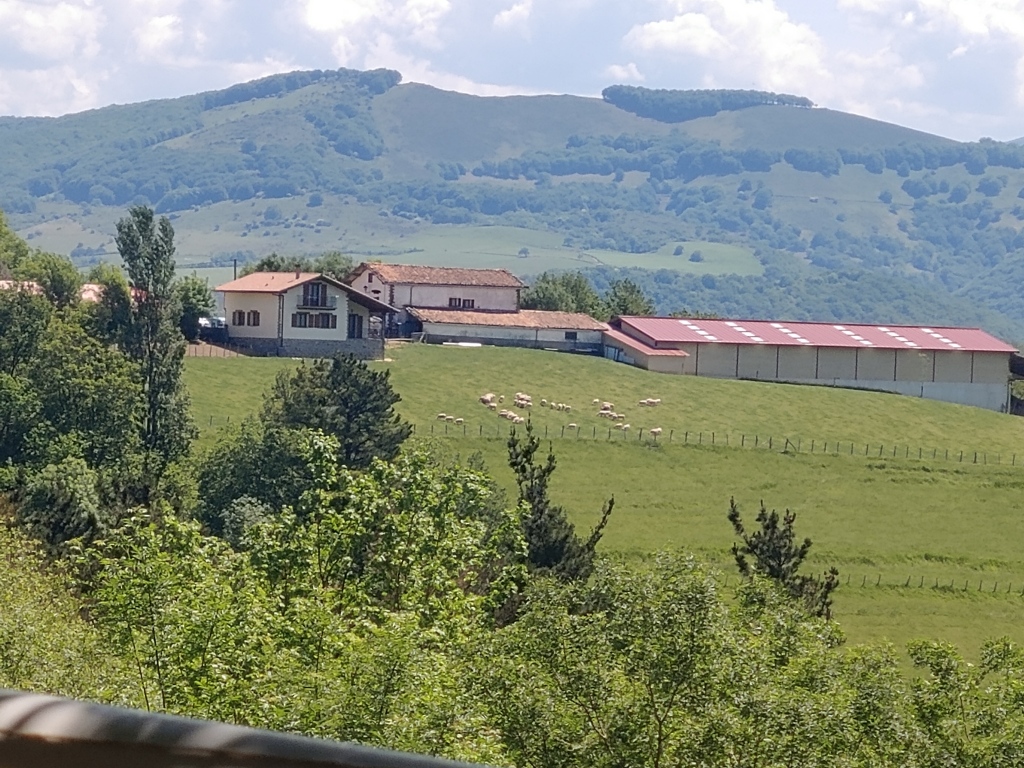
Today across the valley I heard the distant drone of a chain saw. Aside from car wheels on a gravel road, as the song would have it, this is the first mechanized sound I have heard since arriving, and it was far-off and faint, could easily have been the buzz of a bee around my head. It is so quiet that the buzzing of bees is a prominent sound, along with the bells and the baaing and the birdsong. The bells of the sheep clang when they move but yesterday, I didn’t see them move. I looked up from my laptop or my notebook — I was writing on both — and there were sheep in the meadow. The next time I looked up, the sheep were gone.
I mentioned this at last night’s delicious dinner of chicken over couscous. I hear the bells, I see the sheep, I see the sheepless meadow. Someone suggested a sheep TARDIS. I suggested that this place is magical, which it surely is.
We also discussed our next Spanish destinations. I offered up Pamplona, which our hostess Georgina described as a place where she gets her licenses renewed, adding, “Pamplona is Spanish. San Sebastian is Basque.” A return to San Sebastian had been next on my agenda, so I simply canceled Pamplona, which I may do on a day trip, and added a day in San Sebastian, to make it a three-day home base. After that, Bilbao. But it is hard to think of an “after that” when now is so exquisite.
This morning’s lesson was on “character.” In our morning writing session, I filled out a character I had briefly sketched in yesterday’s assignment, “setting,” and added her to the scene. This alarmed my fellow writers when I shared — how had I written so much in twenty minutes? — so I will stick strictly to the assignment tomorrow. But in the meantime, I have perhaps the opening of a short story, if I wrote short stories. I’ve written less than a handful, and only one is published, but this place is magical, so anything could happen.


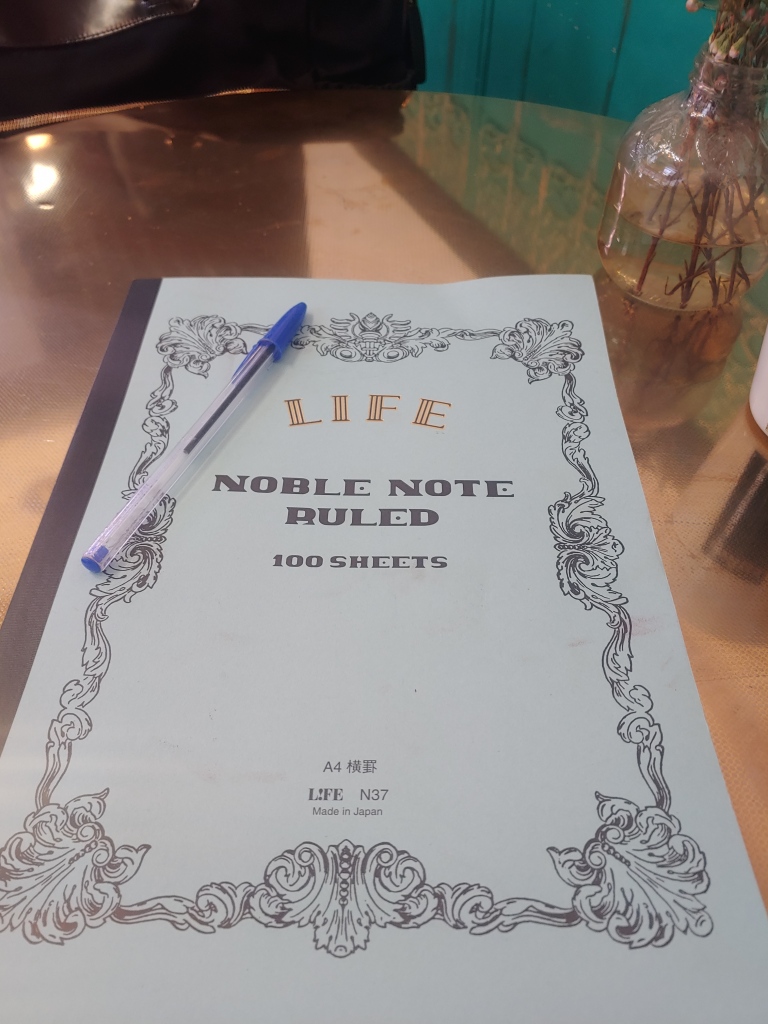
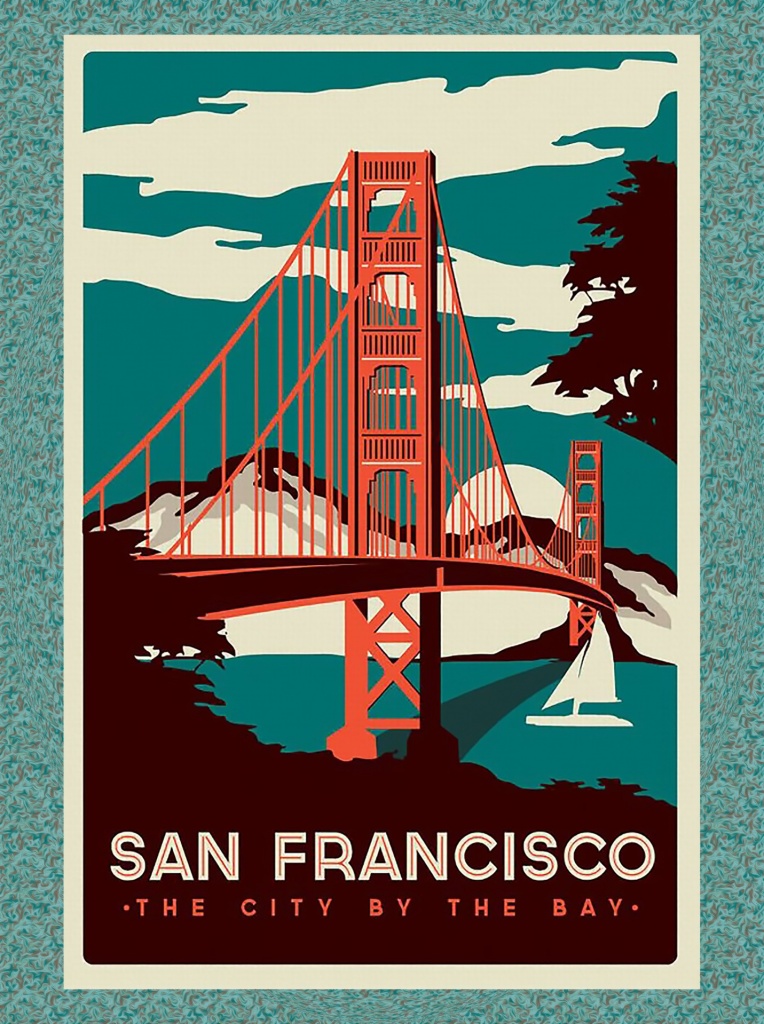
Recent Comments